Scottish Union for Education – Newsletter No55
Newsletter Themes: what schools should teach, the SUE Annual Conference, and Scotland’s changing landscape
This week, SUE met with teacher and educationalist Alka Sehgal Cuthbert to discuss her book What Should Schools Teach? (free to read here). In the past, what teachers taught, and what children could be expected to learn, seemed straightforward. Today, however, we are suffering from a deep-rooted confusion about the role of a school and the purpose of education.
As Alka explained, children learn in several different ways, and they should be learning different things at home and school. Home, among family, is a place where children can learn practical skills (such as how to tie laces) and how to conduct themselves and treat others (morality). Schools are responsible for formal learning: how to read, and write, and do maths. As children grow up, this formal education evolves to help them to appreciate art and literature and to grasp abstract ideas related to the humanities and science.
In recent years, the distinction between home learning and formal education at school has been blurred. Today, parents are often expected to teach children to read and write, while schools want to deal with children’s confidence, self-esteem, sexuality and relationships.
Part of this confusion comes from Scotland’s ‘innovative’ curriculum, the Curriculum for Excellence (CfE). It was introduced over 20 years ago, so we now have an entire generation of young people (and new teachers) educated in this system. CfE is founded on the prejudice that parents can’t be trusted to take care of the social, moral and practical development of their children. It’s not really a curriculum, but more a collection of outcomes and a permanent process of politically, rather than educationally, motivated initiatives. As explicitly stated by the Cabinet Secretary for Education and Skills, Shirley-Anne Somerville, ‘Our schools and our Curriculum seek to promote and inspire a sense of belonging, inclusion and social justice for learners, practitioners and the wider community.’
Through CfE, the old idea that formal education is about handing on knowledge from one generation to the next has been replaced by the shallow idea that ‘skills’ and ‘wellbeing’ are what matters. At the heart of the Scottish curriculum sits a set of ‘indicators’ that now define the purpose of our schools. Guided by SHANARRI, a school is no longer a place where children progressively learn to add, subtract, read and write, based on the best literature, history and scientific knowledge. Instead, a school is now defined as a place where children are Safe, Healthy, Achieving, Nurtured, Active, Respected, Responsible and Included (SHANARRI).
As a society, we expect schools to take good care of our children, but this is not their primary function. Their primary purpose is to provide formal education, to introduce children to all the collective knowledge of society through a framework that makes sense and is appropriate for their age. A real curriculum framework, grounded in knowledge and traditions, would allow teachers to exercise their professional judgement on how to teach well and how the curriculum content could be developed.
How we got to this position and what we can do to change things are the subject of our conference in Glasgow on Saturday 9 March. Below is the agenda for the conference and the second article in our research series on declining standards in Scottish education.
Penny Lewis, Editor
Buy your ticket from Eventbrite here
SUE is hosting its annual conference in Glasgow on Saturday 9 March. It is an opportunity for you to meet other parents, grandparents and teachers who want to see a change for the better in Scottish education. We have some excellent speakers and workshops, and we will be showing the film The Lost Boys, which explores the lives of men who were encouraged to transition when they were young.
Sessions include:
What’s wrong with Scottish Education?
Confronting ‘anti-racist’ indoctrination in schools
Challenging transgender ideology in the classroom
How do we tackle Scotland’s deteriorating educational standards?
Screening of The Lost Boys: searching for manhood
Where do we go from here? A panel of parents and educators discuss how to make changes
Buy your ticket from Eventbrite here
(Tickets should be purchased in advance)
Also, please consider supporting our work by becoming a Founding member of SUE.
Scotland’s changing landscape
In Substack No52, we published the first in a series of articles investigating the possible causes of Scottish school’s poor performance in the PISA survey; this week, Julie Sandilands looks at changes in the broader society and their likely impact on education. Julie is an English and business teacher who worked in several secondary schools in Fife until 2017.
There is no doubt that the Western world is changing, with declining birthrates, increased migration and immigration, political agendas, and cultural shifts being the main factors. Through a series of graphics, this article will highlight the changing landscape in Scotland and ponder on the possible implications these changes might have for the country and its education system.
Declining birthrates
The most recent data show an ever-widening gap between births and deaths. Despite this, Scotland’s population is growing, with the Scottish census reporting that while Scotland’s population in 2022 had risen to 5,436,600 m, up from 5,295,403 m in 2011, ‘Without migration the population would have decreased by around 49,800. But the population has grown because more people moved to Scotland than moved out.’ National Records of Scotland reported that Scotland’s total fertility rate had dropped from 1.30 in 2021 to 1.28 in 2022, a record low. With approximately 1000 fewer births in 2023, this record looks set to be broken.
Points to ponder:
1. Scotland’s reliance on migration and immigration to fill employment gaps across all sectors will continue to rise. However, in an interview with Mark Steyn, writer Louise Perry explains why immigration isn’t the answer to declining birthrates, commenting: ‘We’re not going to be able to just steal young people from other countries, because there aren’t going to be enough to go around.’
2. Crucially, will migrants be wealth creators independent of state subsidies, boosting not only the economy but the decreasing younger age groups, thereby diffusing the demographic time bomb?
3. Culture: Scottish history and linguistic traditions may become more irrelevant, and in some communities disappear altogether. A recent article reported that Gaelic ‘is considered an endangered language’, with fewer than ‘60,000 Gaelic speakers alive today’. This is despite the Gaelic Language Plan 2022 to 2027 initiative created by the Scottish government in a bid to revive and encourage the use of the language.
Demographic changes
The continual rise in immigration is slowly changing the demographics in Scottish schools. Government data show its classification of ‘white Scottish’ pupils to be in decline.
Points to ponder:
1. What expectations does a multicultural society have of the Scottish education system? Perhaps more diverse texts in English, history and geography, or a wider choice in modern languages? In the second edition of What Should Schools Teach?, Alex Standish, when discussing school subjects, reminds us that: ‘In Britain today the nation and many local communities are multicultural, which needs to be reflected in the curriculum. In addition to epistemic knowledge, the curriculum therefore includes social knowledge about the community and its people. This would include historical, geographical and cultural narratives, traditions, festivals, customs, symbols, institutions, norms and significant people, such as great writers, artists and explorers.’ (p. 40).
2. Will growing multiculturalism in the classroom further justify the current push by critical race theorists to ‘decolonise’ individual subjects? Will this result in a narrowing of content, stifling debate and discussion rather than creating opportunities for subject specialists to relate to themes, topics and trends in a wider context, thus enriching any course specification?
3. How can we develop a curriculum that meets the needs of all its users while maintaining high academic standards and a fit-for-purpose assessment framework?
Dwindling numbers of births = dwindling number of pupils
The number of pupils entering the school system has, over time, fluctuated in line with the birthrate, with the expected delay between birth and school age. But with the decline in births from 2008 showing no signs of reversing, not only are the numbers already having an impact (400,312 primary pupils in 2017 down to 384,725 in 2023), they are also unlikely to follow previous trends. Ultimately, this will affect the secondary sector before the end of the decade.
Points to ponder:
1. What effect will this have on future teacher recruitment, retention and job opportunities? What commitment will the government of the day make to maintain teacher numbers in the face of falling school rolls?
2. This could be the opportunity to reduce class sizes, thus creating a more personalised pupil experience while at the same time improving outcomes for those less socially mobile to achieve their full potential. This is the underlying principle of the Scottish Attainment Challenge, which, as reported by SUE here, despite being very well funded, has so far failed to provide any notable returns on the vast taxpayer investment.
Rising number of pupils registered with an additional support need
School statistics shows that ‘in 2023, 37% of all pupils (259,036 individuals) had an additional support need (ASN) [...] This is 2.8 percentage points higher than 2022 when 34.2% of pupils had an additional support need.’ In 2021, addressing the rise in ASN numbers, the Scottish government commented: ‘The number of pupils recorded with ASN has increased markedly since 2010 and there continue to be year on year increases [...] These increases were likely due in part to continued improvements in recording and the introduction of the additional need types “Child plans” and “Other” in 2011.’
Points to ponder:
1. Given that, in comparison, 17% of pupils have an identified Special Educational Need (SEN) in England, a rigorous review by the Scottish government, including of its recording and categorising procedures, is well overdue, because if the current trend continues, by 2030 Scotland might find itself in the embarrassing position of having to explain to its people, the rest of the UK, and the world, why 50% of pupils in Scottish schools are labelled as having additional support needs.
2. The financial demand for resources is not sustainable and risks necessitating budget cuts in other areas of the sector, as well as placing ever-increasing demands on teachers endeavouring to deliver the curriculum while at the same time ‘getting it right for every child’.
3. The implications of accommodating individuals with an additional support need or SEN statement do not simply stop at the school gate once a pupil reaches school-leaving age, but reach into further/higher education institutions and the workplace.
Age profile of teachers
The age profile of teachers over the past 10 years, indicating the exodus of teachers aged 52-plus, suggests that schools are becoming increasingly reliant on younger staff.
Points to ponder:
1. A growing number of experienced teachers are leaving the profession up to 15 years before state pension age to become economically inactive or to seek alternative employment. Perhaps an investigation into the reasons for this would help to reverse, or at least slow, the trend?
2. School communities risk no longer reflecting the societal norms in terms of representing the presence of multiple generational groups, with teaching generally viewed as unsuitable for the post-50 age group, inadvertently creating a barrier to employment for older teachers.
3. A recent freedom of information request by Willie Rennie (Scottish Liberal Democrats) to the General Teaching Council for Scotland highlighted that, ‘since 2018, 1,337 registrants have permanently left the register, within 5 years of gaining provisional registration.’
In addition to a lack of continuity in the classroom, an outflow of younger and older teachers reduces further the ability to provide a rich, diverse education service.
Teacher sex by sector
The teaching profession has traditionally been dominated by female staff, especially in the primary sector. These figures have remained unchanged since 2014.
Points to ponder:
1. Would a more balanced ratio of male-to-female staff be beneficial in creating a conducive learning environment as well as being more representative of the world of work?
2. Would a recruitment drive by initial teacher education institutions targeting male applicants help to increase numbers and raise professional awareness in that group?
Changes in society are inevitable, and not all are due to political will. However, if wilfully ignored, a possible catastrophe could be looming in the not-too-distant future. Individually, each point raised may not suggest so, but collectively they have the potential to upend the current system, causing long-term irreparable damage. Regardless of who holds the balance of power in Holyrood after the 2024 general election, there is an opportunity now for the people of Scotland to have a healthy debate on how to best manage change, and to agree on a shared vision for the country while creating a first-class, truly inclusive education system that can hold its own on the world stage. The will of the people, once heard, should then be executed by representatives, elected and paid for by the people. Isn’t that how democracies work?
Annual school education data can be viewed at https://www.gov.scot/collections/school-education-statistics/.
News round-up
A selection of the main stories with relevance to Scottish education in the press in recent weeks, by Simon Knight
https://www.heraldscotland.com/news/24112591.conversion-therapy-ban-outwith-holyroods-powers-says-top-kc/?ref=ebbn&nid=1388&u=3113c1b3a77b3e25e409aaa02c22166f&date=120224 Andrew Learmonth, Conversion therapy ban outwith Holyrood’s powers, says top KC. 12/02/24
https://archive.is/2024.02.06-120023/https://www.thetimes.co.uk/article/elites-pious-posturing-is-no-help-to-the-poor-pgmpkp0nt James Marriott, Private school posturing ignores the poor. 31/01/24
https://substack.com/home/post/p-141553041?source=queue Andrew Doyle, The New Gay Conversion Therapy. The ignorance of politicians is putting gay people at risk. 10/02/24
https://www.dailywire.com/news/utterly-brilliant-viral-video-shows-the-moment-student-realizes-his-claim-of-j-k-rowlings-bigotry-is-unfounded?utm_source=facebook&utm_medium=social&utm_campaign=dwbrand Virginia Kruta, ‘Utterly Brilliant’: Viral Video Shows The Moment Student Realizes His Claim Of J.K. Rowling’s ‘Bigotry’ Is Unfounded 06/02/24
https://substack.com/home/post/p-141590536?source=queue Andrew Doyle, Labour Has a Misogyny Problem. My interview with writer Joan Smith. 12/02/24
https://archive.is/GPqSp James McEnaney, Here’s what happened when I investigated the SNP education plan. 12/02/24
https://archive.is/PNV5e Hayley Dixon, John Lewis magazine gives tips on breast binders for trans children. Partnership faces calls for boycott after critics brand guidance in staff publication ‘dangerous’ and ‘irresponsible’. 15/02/24
https://archive.is/aUiXC Will Hazell, Socialist Sunday school accused of making ‘anti-Israel propaganda’ magazine with children. Attendees as young as eight contributed to publication with the controversial ‘from the river to the sea’ slogan. 17/02/24
Colin Wright, Biologist PZ Myers Peddles Sex Pseudoscience (Again). Myers’ attempted critique of Richard Dawkins only revealed the depths of his own scientific ignorance. 17/02/24
Thanks for reading the SUE Newsletter.
Please visit our Substack
Please join the union and get in touch with our organisers.
Email us at info@scottishunionforeducation.co.uk
Contact SUEs Parents and Supporters Group at PSG@scottishunionforeducation.co.uk
Follow SUE on X (FKA Twitter)
Please pass this newsletter on to your friends, family and workmates.





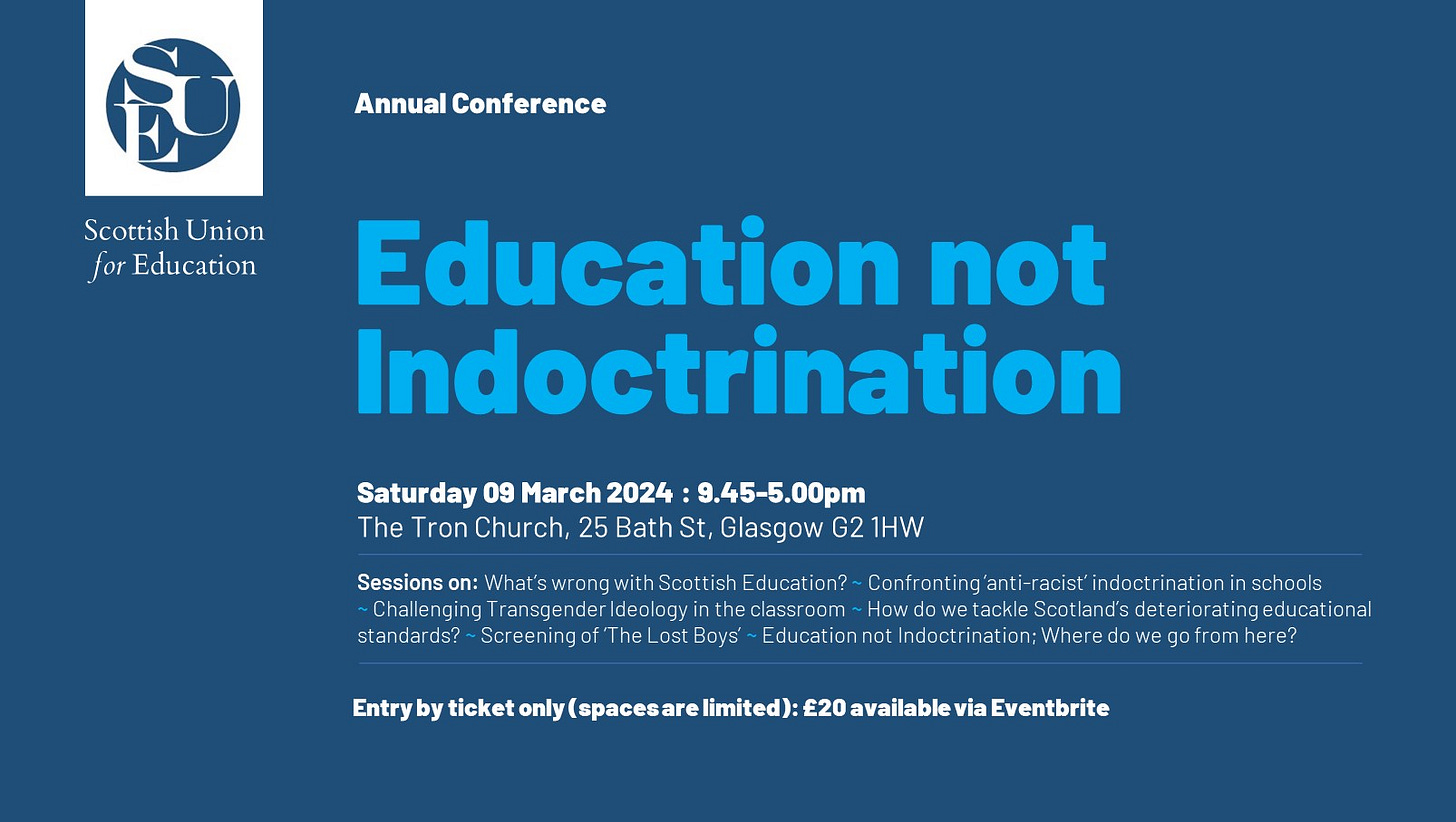
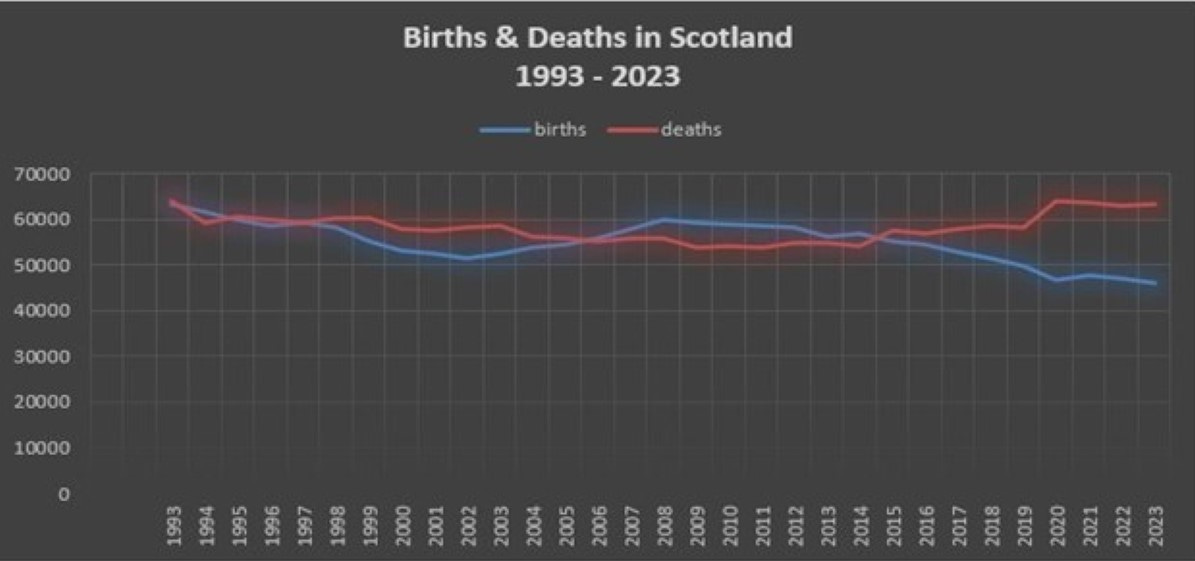

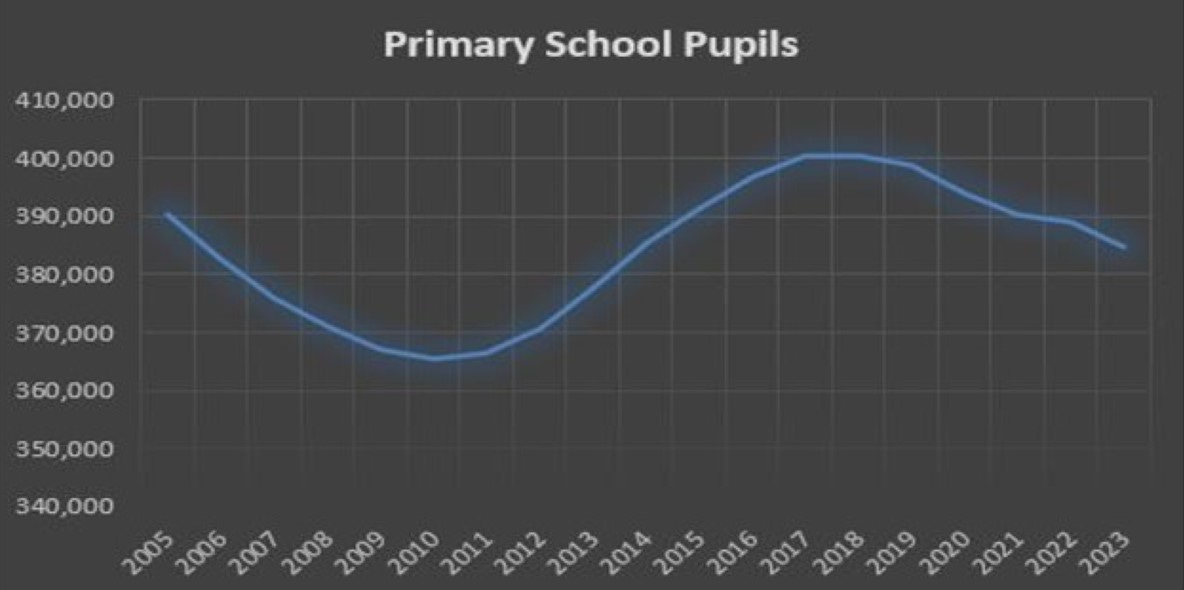

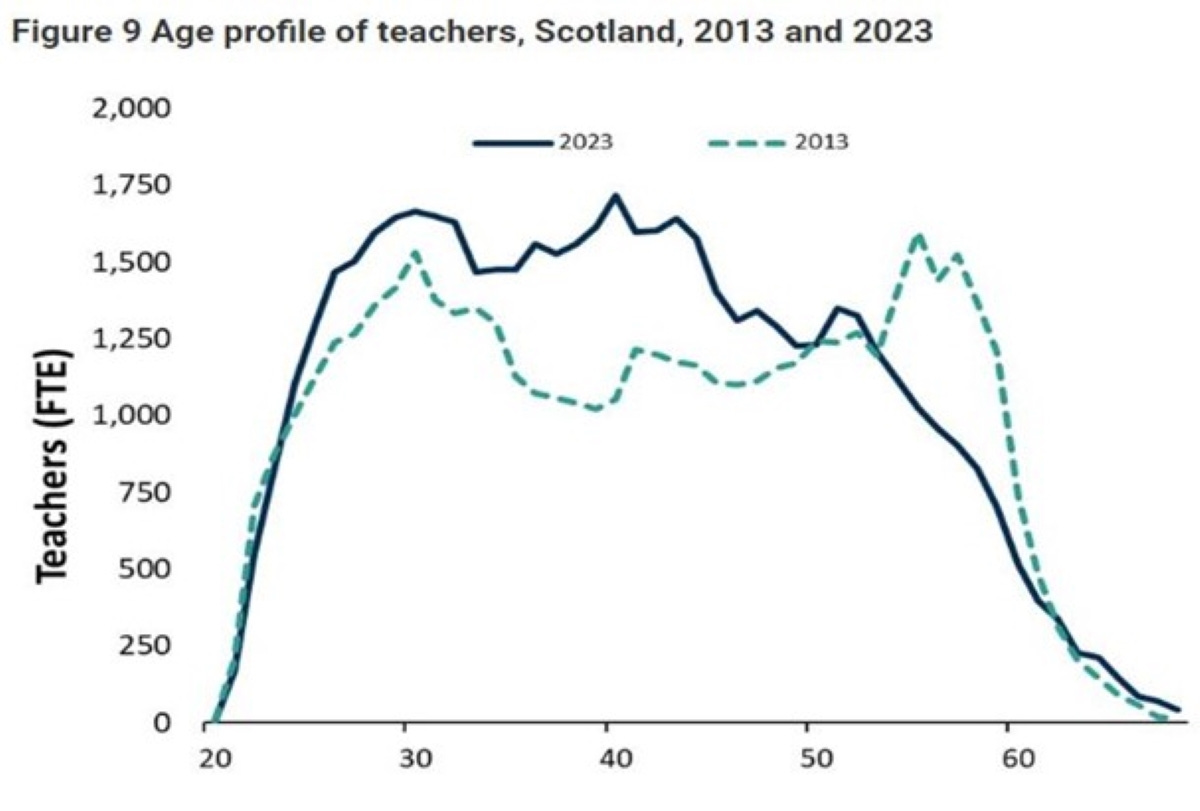
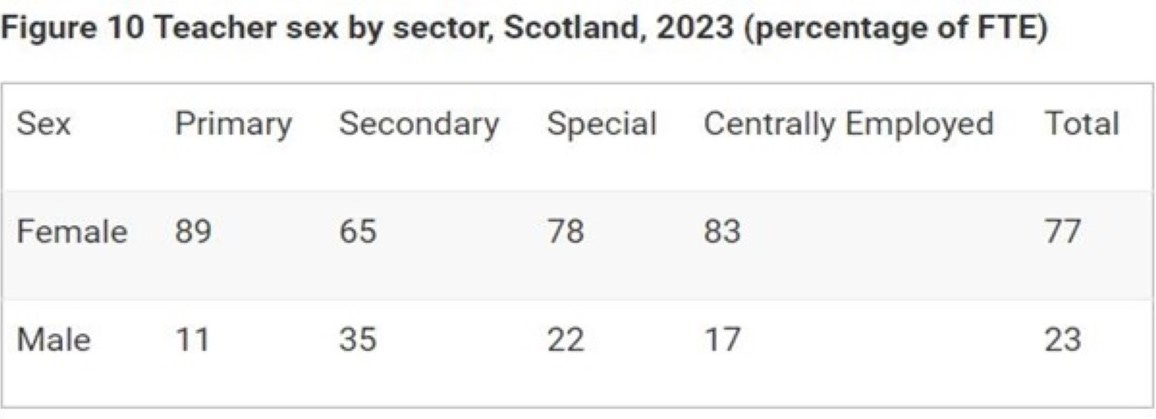

The money set to address ‘the attainment gap’ is a joke. My son is one of the ‘recipients’ of Pupil Equity Funds. Both his schools have received £1200 a year for his six years in education to support his learning. I have no evidence any special support was offered to him. He kept being passed
over as ‘on track’ despite my protestations. Finally
Got him independently assessed in P5. Was found to have a P2 level of reading and writing (!) - my sister pays for him to have a private tutor weekly which has completely turned things around. This is what the school should have been doing. His old
school spent loads of time on poster campaigns for social justice issues and yet he could not read or write properly.